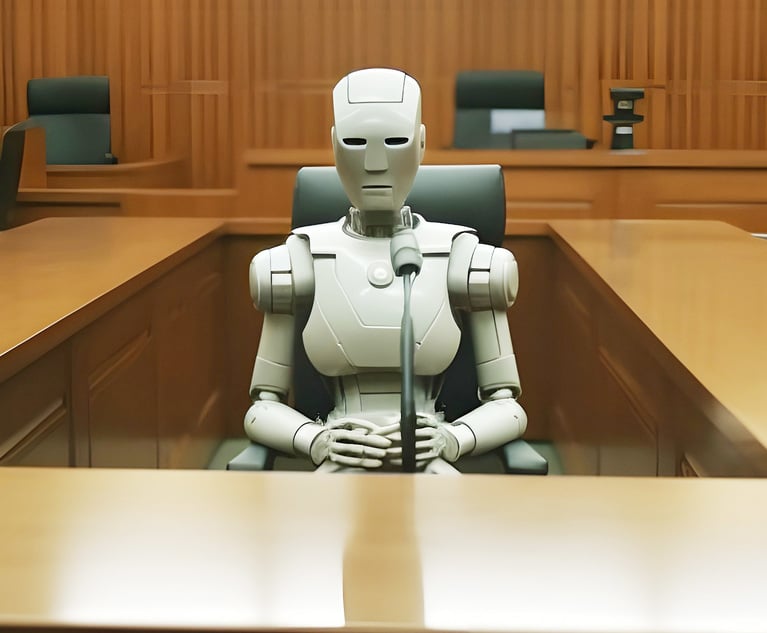Touching the future: Patents on graphical user interfaces on the rise
Almost everything about the ornamental aspects of a GUI is protectable via design patent in the U.S., assuming the GUI has met the novelty standards for patents.
March 05, 2014 at 03:00 AM
9 minute read
The original version of this story was published on Law.com
In the last article, “The case for design patents in manufacturing and industrial technologies,” we explored the business case for pursuing design patents in industries that have not traditionally focused on design patents. In this article, we will explore another area of design patent law that is quickly growing and provides another opportunity for forward thinking companies to procure patents on subject matter that has traditionally been reserved for copyright, or has not been protected at all.
We interact with graphical user interfaces (GUIs) every day through phones, computers, gaming devices, ATMs, and other electronic devices. GUIs are simply the icons, screen layout, and visual cues that we utilize to control these devices. The use of GUIs is on the rise, spanning many areas of technology including home appliances, airline check-in kiosks, and office equipment, among others. Certainly, one of the reasons the popularity and focus on GUIs is heightened is due to the success of Apple and its laserlike focus on the user experience. Apple has long been known for sleek product design and usability, which has allowed the company to build a rampant following among users who boast about the intuitive Apple interfaces. It could be easily argued that the usability aspects of the Apple products are core elements to the Apple business and product lines. Protecting these critical aspects of the business has allowed Apple to maintain a consistent “look and feel” across the GUIs used in all of its product lines including the iPhone, iPad, and various MacBook computers.
As such, there are many aspects about GUIs that are protectable in the United States via design patents. First, novel icons associated with GUIs are protectable via design patent. At its most basic, icons are key visual representations of your company and your brand, and act as a signifier to the subject matter associated with the application. Well-known icons include an envelope representing e-mail and a music note representing a music player. In the situation of third party application (app) developers, an icon is a visual reminder to a user that the app has been downloaded and is ready for use. The app icon may be the single most powerful way for a company to convey its brand, hence the importance of protecting it.
After a user clicks on an icon, a program opens and a GUI is displayed. Novel aspects about the layout of the GUI, including the specific location of each element, are also protectable. For example, when opening a music player app, a user may be confronted with an album cover with numerous control buttons displayed below the album cover in a specific layout. The overall configuration of the album cover, in conjunction with the control buttons, is protectable so long as the configuration is new and nonobvious.
Finally, movement (i.e., animation) through the GUI is also protectable. More specifically, when a user dictates a command to the GUI, the system responds in a certain manner — most often, the movement involves a new screen opening, or something changing on the current screen. For example, when a user is listening to a song in the music app and presses the “next” button, the album cover quickly slides to the left off the screen, while at the same time a new album cover appears from the right side of the screen. This “movement” of the album cover is a classic example of the types of elements in a GUI that are protectable via design patent. One of the most famous examples of protection of movement in a GUI is the Apple “Cover Flow” design patent, which protects flipping through albums in the iTunes and music player interface.
Ultimately, almost everything about the ornamental aspects of a GUI is protectable via design patent in the U.S., assuming the GUI has met the novelty standards for patents. Everything from screen layout (including the specific placement of icons), to the individual screens that appear in a GUI, to the specific user commands that cause movement of a component in the GUI, is protectable. In the software space, and especially in the app developer space, protection of the GUI may be the most important type of intellectual property acquired by the developer to preserve the brand of the company. Protection of GUIs should not be limited to the world of software. Instead, companies in all industries should strongly consider protection of GUIs to add another layer of IP protection to their products. Protection of graphical user interfaces is a must for any company that uses an interface to connect with its audience.
In the last article, “The case for design patents in manufacturing and industrial technologies,” we explored the business case for pursuing design patents in industries that have not traditionally focused on design patents. In this article, we will explore another area of design patent law that is quickly growing and provides another opportunity for forward thinking companies to procure patents on subject matter that has traditionally been reserved for copyright, or has not been protected at all.
We interact with graphical user interfaces (GUIs) every day through phones, computers, gaming devices, ATMs, and other electronic devices. GUIs are simply the icons, screen layout, and visual cues that we utilize to control these devices. The use of GUIs is on the rise, spanning many areas of technology including home appliances, airline check-in kiosks, and office equipment, among others. Certainly, one of the reasons the popularity and focus on GUIs is heightened is due to the success of
As such, there are many aspects about GUIs that are protectable in the United States via design patents. First, novel icons associated with GUIs are protectable via design patent. At its most basic, icons are key visual representations of your company and your brand, and act as a signifier to the subject matter associated with the application. Well-known icons include an envelope representing e-mail and a music note representing a music player. In the situation of third party application (app) developers, an icon is a visual reminder to a user that the app has been downloaded and is ready for use. The app icon may be the single most powerful way for a company to convey its brand, hence the importance of protecting it.
After a user clicks on an icon, a program opens and a GUI is displayed. Novel aspects about the layout of the GUI, including the specific location of each element, are also protectable. For example, when opening a music player app, a user may be confronted with an album cover with numerous control buttons displayed below the album cover in a specific layout. The overall configuration of the album cover, in conjunction with the control buttons, is protectable so long as the configuration is new and nonobvious.
Finally, movement (i.e., animation) through the GUI is also protectable. More specifically, when a user dictates a command to the GUI, the system responds in a certain manner — most often, the movement involves a new screen opening, or something changing on the current screen. For example, when a user is listening to a song in the music app and presses the “next” button, the album cover quickly slides to the left off the screen, while at the same time a new album cover appears from the right side of the screen. This “movement” of the album cover is a classic example of the types of elements in a GUI that are protectable via design patent. One of the most famous examples of protection of movement in a GUI is the
Ultimately, almost everything about the ornamental aspects of a GUI is protectable via design patent in the U.S., assuming the GUI has met the novelty standards for patents. Everything from screen layout (including the specific placement of icons), to the individual screens that appear in a GUI, to the specific user commands that cause movement of a component in the GUI, is protectable. In the software space, and especially in the app developer space, protection of the GUI may be the most important type of intellectual property acquired by the developer to preserve the brand of the company. Protection of GUIs should not be limited to the world of software. Instead, companies in all industries should strongly consider protection of GUIs to add another layer of IP protection to their products. Protection of graphical user interfaces is a must for any company that uses an interface to connect with its audience.
This content has been archived. It is available through our partners, LexisNexis® and Bloomberg Law.
To view this content, please continue to their sites.
Not a Lexis Subscriber?
Subscribe Now
Not a Bloomberg Law Subscriber?
Subscribe Now
NOT FOR REPRINT
© 2024 ALM Global, LLC, All Rights Reserved. Request academic re-use from www.copyright.com. All other uses, submit a request to [email protected]. For more information visit Asset & Logo Licensing.
You Might Like
View All
Meta Hit With Class Action for Allegedly Using Pirated Books to Train AI Models


In-House Lawyers Weigh In on How AI Will Revolutionize Dispute Resolution
Trending Stories
- 1A&O Shearman Adopts 3-Level Lockstep Pay Model Amid Shift to All-Equity Partnership
- 2A RICO Surge Is Underway: Here's How the Allstate Push Might Play Out
- 3The Law Firm Disrupted: Playing the Talent Game to Win
- 4Data-Driven Legal Strategies
- 5Preparing Your Law Firm for 2025: Smart Ways to Embrace AI & Other Technologies
Featured Firms
Law Offices of Gary Martin Hays & Associates, P.C.
(470) 294-1674
Law Offices of Mark E. Salomone
(857) 444-6468
Smith & Hassler
(713) 739-1250







